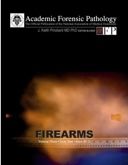Academic forensic pathology
Abbreviation:
Acad. Forensic Pathol.
Published by:
National Association of Medical Examiners
Publisher Location: Calgary, Alta., Canada
Journal Website:
https://journals.sagepub.com/loi/afpa
Range of citations in the SafetyLit database:
2013; 3(2) --
2024; 14(1)
Publication Date Range:
2011 --
Number of articles from this journal included in the SafetyLit database:
126
(Download all articles from this journal in CSV format.)
eISSN = 1925-3621
Find a library that holds this journal: http://worldcat.org/issn/19253621
Journal Language(s):
English
Aims and Scope (from publisher):
Academic Forensic Pathology: The Official Publication of the National Association of Medical Examiners is committed to publishing high quality, timely, and relevant scholarly manuscripts of importance to the practice of forensic pathology. We define forensic pathology as the medical subspecialty wherein practitioners observe, document, and interpret the medicolegal significance of injuries and diseases in both living and deceased humans.
The reputation of our (and any) medical specialty is in large part a function of the scholarly literature it produces. The vision of the Editor-In-Chief and the Publisher is for a forensic pathology journal that is worthy of representing our field. High quality, timely, and relevant are the descriptors we promote. As the quality of our literature directly reflects the reputation of our field, we can only afford to publish high quality manuscripts that demonstrate that we forensic pathologists understand the basic principles of science, and that we understand and utilize the basic principles of evidence-based medicine. To accomplish this, we must take an innovative and visionary approach to publishing. Our profession is very small, and for decades has been built around countless fascinating stories. This leads to an (over) abundance of single case reports and small case series. Despite the fact that data, tissue, and new (scholarly) ideas are plentiful, the lack of a single full-time researcher in the field combined with severe limitations of funding (within individual offices, from grant-conferring agencies, and within the field on the whole), the generalized understaffed and overworked nature of most offices, complicated ethical considerations around human tissue retention and research, and other issues all contribute toward making it a challenge to have successful academic ventures.
We strive to produce an excellent periodical that stands toe-to-toe with the top clinical journals of other medical specialties. To strive for less does not make sense, and further promotes the misconception that forensic pathologists are not “real” doctors, do not really practice medicine, and are somehow less valuable to our communities than our clinical colleagues.
Success starts with recognition that our field is different – forensic pathology is populated with practitioners who are predominantly paid to function as “service pathologists.” As such, any forensic pathology journal model reliant on the output of forensic pathology researchers, or “traditional academics” will fail. Recognizing this, our Journal takes a practical approach to scholarly publishing. Each issue highlights a specific, predetermined topic, and approximately half of each issue ultimately consists of invited reviews that successfully navigate stringent peer review. By reducing our reliance on unsolicited manuscripts, we can more stringently scrutinize original article submissions and thus commit to publishing only “the best of the best” science in our profession. We believe that by setting a very high standard for acceptance into publication, our Journal will promote a higher quality of research in the field as a whole, and will thereby improve our visibility and reputation amongst our clinical colleagues.
